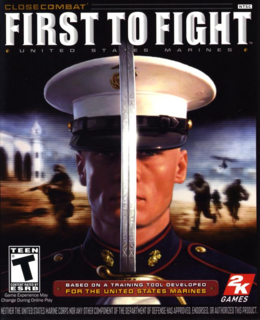Close Combat: First to Fight
Developed with input from over 40 active-duty Marines, First to Fight is an urban combat game set in a war-torn 2006 Beirut. As the head of a four-man Marine fire team, you must lead your RTFA (Ready Team Fire Assist) squad through six hectic missions subdivided into 22 levels. Your three teammates consist of a SAW gunner (equipped with an M249 machinegun), an assistant gunner, and a rifleman. You can't directly control these soldiers, but you can individually or collectively order them to perform specific tasks, such as "Go To," "Form Up," and "Give Suppressing Fire." When breaching a closed room, you can also direct them to execute a Takedown (or Frag Takedown) maneuver to minimize your exposure to enemy fire. There are some built-in tutorials explaining the procedures, but they're non-interactive, and like the game's coarsely animated FMV cutscenes, largely forgettable.
The game also features a MAGTF (Marine Air-Ground Task Force) component that permits you to call in air and mortar strikes against dug-in enemy positions or request a Marine sniper when your team's pinned down outdoors. This support is limited, so you have to pick and choose when it's really needed.
Weapons selection is limited, but the default M-16 A4 is all the gun you really need.
The RTFA concept is intriguing and adds significantly to the FPS dynamic. It's good to know that someone's got your back when you're advancing down a dark alley, and FtF models these real-world Marine tactics quite convincingly. Your team will seek cover from surrounding buildings and vehicles as they move while orienting themselves to cover potential fire sectors and provide 360-degree security from OPFOR (Opposing Forces) attacks. This four-way buddy system is extremely effective in an urban setting where enemy fire can come from any direction, including windows and rooftops.
Unfortunately, the A.I. isn't sophisticated enough to pull it off with any consistency. When an enemy gunman jumps out from behind or above you, your trailing teammates will identify and engage the threat, but it's a real coin toss whether they'll dispatch him effectively. I witnessed a number of firefights where my guys used an entire magazine to kill a bad guy from point blank range and many more where they stood rooted to the spot (while completely exposed), ingesting round after lethal round of OPFOR fire.
The enemy A.I. is similarly inconsistent. Some will shoot from behind cover, smartly evading your team's return fire, while others openly stagger towards you in some ludicrous Night of the Living Dead impression. (A cursory psychology model is in place here, but "suicidal" doesn't quite fit). These rag-tag Lebanese, Syrian, Iranian, and Arab radicals -- they're pretty easy to spot, just look for a turban and a scruffy beard -- are also quite the Chatty Cathys. As you near their "hidden" positions, they'll erupt into spontaneous Arabic conversation to let you know you're getting close. Even when they're alone.
The brevity of the six-mission single-player game is the single biggest letdown. At the lowest difficulty setting, experienced FPS gamers can whip through all 22 levels in a mere four or five hours. You can double this by switching to "simulation" mode (where a single bullet can end your life and send you back to your last save-game checkpoint), but the higher difficulty setting also exacerbates the game's many A.I. faults. You pretty much have to crawl if you don't want to lose team members to their own incompetence.
Mercifully, most of these A.I. deficiencies are non-issues in FtF's engaging multiplayer game. Playable over a LAN or an Internet connection, you can buddy up with three humans to replay any of the game's single-player missions (against an A.I. enemy) or alternatively pit your four-man fire team against another human squad in one of the FTA deathmatch arenas. The in-game lobbies are usually well populated, and the on-screen action is consistently entertaining and surprisingly lag-free. (As an added bonus, you get access to a slew of new weapons in the Modified Co-Op mode).
The game's murky graphics often force you to use your night-vision goggles.
Destineer won't win any major graphics awards for First to Fight, but if you can overlook the occasional visual blemish (framerate bottlenecks and shadows passing through walls to name two), the game still deserves kudos for its detailed character renders and impressive war-damaged Beirut backdrops. The murky lighting forces you to don night-vision goggles a few too many times, even in daytime scenarios, and, ironically, the bad guys don't seem to require any technological assistance to frag you in the dark.

